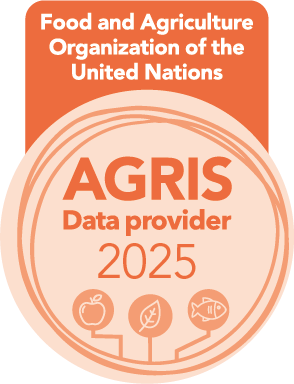Revolutionizing Potato Farming: Dynamic Innovations Reshaping Late Blight Control in Pakistan
Revolutionizing Potato Farming
DOI:
https://doi.org/10.54393/df.v4i03.96Keywords:
Potato Late Blight Disease, Crop Yield, Solanum tuberosumAbstract
Potato (Solanum tuberosum L.) is one of the most extensively cultivated crops around the world, and Pakistan’s weather favor production and cultivation. Despite the ease of cultivating potatoes and the nominal labor supplies, Pakistan’s output of potatoes has not yet achieved a promising level when compared to nearby nations like India and Bangladesh. The crop's low production in Pakistan is caused by several biotic and abiotic stresses that instigated several pathogenic diseases such as early blight, bacterial wilt, viral infections, nematode infestations and late blight. Late blight disease is one of the most dreaded diseases of potatoes globally. It is caused by the fungus Phytophthora infestans which is highly adaptive to fungicides. Several fungicides have been in use against this disease for a long time, however, it has developed a high degree of resistant strains to these fungicides due to their unselective use over time and ultimately may cause colossal losses to the crop. In response, scientists have developed different potato varieties like Setanta, Nicola, Cara and Acoustic that are highly resistant to late blight. Similarly, cultural methods are also employed to combat late blight disease. This article provides an overview of the implications of late blight disease in potato cultivation and explores various strategies to reduce yield losses brought on by this disease via the application of synthetic fungicides.
References
Hardigan MA, Laimbeer FPE, Newton L, Crisovan E, Hamilton JP, Vaillancourt B, et al. Genome diversity of tuber-bearing Solanum uncovers complex evolutionary history and targets of domestication in the cultivated potato. Proceedings of the National Academy of Sciences. 2017 Nov; 114(46): E9999-E10008. doi: 10.1073/pnas.1714380114. DOI: https://doi.org/10.1073/pnas.1714380114
Abbas A, Mubeen M, Younus W, Shakeel Q, Iftikhar Y, Bashir S, et al. Plant Diseases and Pests, Growing Threats to Food Security of Gilgit-Baltistan, Pakistan. Sarhad Journal of Agriculture. 2023 Jun; 39(2): 511-20. doi: 10.17582/journal.sja/2023/39.2.510.520. DOI: https://doi.org/10.17582/journal.sja/2023/39.2.510.520
Raza W, Ghazanfar MU, Sullivan L, Cooke DE, Cooke LR. Mating type and aggressiveness of Phytophthora infestans (Mont.) de Bary in potato-growing areas of Punjab, Pakistan, 2017–2018 and identification of genotype 13_A2 in 2019–2020. Potato Research. 2021 Mar; 64: 115-29. doi: 10.1007/s11540-020-09467-9. DOI: https://doi.org/10.1007/s11540-020-09467-9
Shad N, Liaquat I, Khan IH, Hussain N, Liaqat GA, Javaid A. Evaluation of cytrol and revus fungicides against late blight of potato. Pakistan Journal of Phytopathology. 2020 Dec; 32(2): 225-9. doi: 10.33866/phytopathol.030.02.0598. DOI: https://doi.org/10.33866/phytopathol.030.02.0598
Wang X, Zheng K, Cheng W, Li J, Liang X, Shen J, et al. Field application of star polymer-delivered chitosan to amplify plant defense against potato late blight. Chemical Engineering Journal. 2021 Aug; 417: 129327. doi: 10.1016/j.cej.2021.129327. DOI: https://doi.org/10.1016/j.cej.2021.129327
Anenberg SC, West JJ, Fiore AM, Jaffe DA, Prather MJ, Bergmann D, et al. Intercontinental impacts of ozone pollution on human mortality. 2009 Aug; 43(17): 6482-7. doi: 10.1021/es900518z. DOI: https://doi.org/10.1021/es900518z
Coca-Morante M and Tolín-Tordoya I. The Potato late blight caused by Phytophthora infestans Mont de Bary as selection factor of phurejas potatoes (Solanum phureja Juz et Buk) in endemic areas of the bolivian Andes. American Journal of Plant Sciences 2012 Dec; 4(1): 1-6.
Dayarathne MC, Mridha AU, Wang Y. Diagnosis of fungal plant pathogens using conventional and molecular approaches. Diagnostics of Plant Diseases. 2020 Dec. doi: 10.5772/intechopen.94980. DOI: https://doi.org/10.5772/intechopen.94980
Fenu G and Malloci FM. Artificial intelligence technique in crop disease forecasting: A case study on potato late blight prediction. InIntelligent Decision Technologies: Proceedings of the 12th KES International Conference on Intelligent Decision Technologies (KES-IDT 2020). Springer Singapore. 2020 Jun; 193: 79-89. doi: 10.1007/978-981-15-5925-9_7. DOI: https://doi.org/10.1007/978-981-15-5925-9_7
Kalyandurg PB, Sundararajan P, Dubey M, Ghadamgahi F, Zahid MA, Whisson SC, et al. Spray-induced gene silencing as a potential tool to control potato late blight disease. Phytopathology®. 2021 Dec; 111(12): 2168-75. doi: 10.1094/PHYTO-02-21-0054-SC. DOI: https://doi.org/10.1094/PHYTO-02-21-0054-SC
Tiwari I, Shah KK, Tripathi S, Modi B, Subedi S, Shrestha J. Late blight of potato and its management through the application of different fungicides and organic amendments: a review. Journal of Agriculture and Natural Resources. 2021 Jan; 4(1): 301-20. doi: 10.3126/janr.v4i1.33374. DOI: https://doi.org/10.3126/janr.v4i1.33374
Cieslik K, Cecchi F, Damtew EA, Tafesse S, Struik PC, Lemaga B, et al. The role of ICT in collective management of public bads: The case of potato late blight in Ethiopia. World Development. 2021 Apr; 140: 105366. doi: 10.1016/j.worlddev.2020.105366. DOI: https://doi.org/10.1016/j.worlddev.2020.105366
Kassaw A, Abera M, Belete E. The response of potato late blight to potato varieties and fungicide spraying frequencies at Meket, Ethiopia. Cogent Food & Agriculture. 2021 Jan; 7(1): 1870309. doi: 10.1080/23311932.2020.1870309. DOI: https://doi.org/10.1080/23311932.2020.1870309
Kange AM and Rosana EM. Effects of Fertilizer and Fungicide Application Rates on Late Blight Disease and Growth of Irish Potato (Solanum Tuberosum L.). African Journal of Biological Sciences. 2022 Apr; 4(2): 19-30. doi: 10.33472/AFJBS.4.2.2022.19-30. DOI: https://doi.org/10.33472/AFJBS.4.2.2022.19-30
Widmark A-K. The late blight pathogen, Phytophthora infestans. Acta Universitatis Agriculturae Sueciae. Doctoral Thesis. 2010.
Subhani MN, Sahi ST, Rehman A, Wakil W. Effect of late bligh t caused by Phytophthora infestans(Mont.) de Bary on Phosphorus i n leaves of advanced potato lines/cultivars. Academic Research Journal of Agricultural Science and Research. 2015 Jan; 3(1): 4-7.
Majeed A, Siyar S, Sami S. Late blight of potato: From the great Irish potato famine to the genomic era–An overview. Hellenic Plant Protection Journal. 2022 Jan; 15(1): 1-9. doi: 10.2478/hppj-2022-0001. DOI: https://doi.org/10.2478/hppj-2022-0001
Ghatak A, Rao K, Balodi R, Bisht S. Plant disease diagnosis: technological advancements and challenges. Indian Phytopathology. 2017 Sep; 70(3): 275-81. doi: 10.24838/ip.2017.v70.i3.72487.
Ghazanfar MU, Sahi ST, Wakil W, Iqbal Z. Evaluation of various fungicides for the management of late blight of potato (Phytophthora infestans). Pakiatan Journal of Phytopathology. 2010; 22(2): 83-8.
Abdirahman SH, Joseph MJ, Kimurto PK, Nyongesa M. Efficacy of Biofertilizers and Farmyard Manure in Management of Late Blight (Phytophthora infestans) and Yield of Potato. World. 2023 Jul; 11(2): 59-67. doi: 10.12691/wjar-11-2-4. DOI: https://doi.org/10.12691/wjar-11-2-4
Majeed A, Muhammad Z, Ullah Z, Ullah R, Ahmad H. Late blight of potato (Phytophthora infestans) I: Fungicides application and associated challenges. Turkish Journal of Agriculture-Food Science and Technology. 2017 Mar; 5(3): 261-6. doi: 10.24925/turjaf.v5i3.261-266.1038. DOI: https://doi.org/10.24925/turjaf.v5i3.261-266.1038
Goutam U, Thakur K, Salaria N, Kukreja S. Recent approaches for late blight disease management of potato caused by Phytophthora infestans. Fungi and their Role in Sustainable Development: Current Perspectives. 2018 :311-25. doi: 10.1007/978-981-13-0393-7_18. DOI: https://doi.org/10.1007/978-981-13-0393-7_18
Daaboub A, Radouane N, Tahiri A, Belabess Z, Amiri S, Kowalska J, et al. Biological Control Using Beneficial Microorganisms as an Alternative to Synthetic Fungicides for Managing Late Blight Disease. Potato Research. 2022 Dec; 65(4): 991-1013. doi: 10.1007/s11540-022-09555-y. DOI: https://doi.org/10.1007/s11540-022-09555-y
Pel MA. Mapping, isolation and characterization of genes responsible for late blight resistance in potato: Wageningen University and Research; 2010. Available at: https://www.proquest.com/openview/e6a4d6905e5625e9ed4c3d408d709904/1?pq-origsite=gscholar&cbl=2026366&diss=y.
Devi AR, Kotoky R, Pandey P, Sharma G. Application of Bacillus spp. for sustainable cultivation of potato (Solanum tuberosum L.) and the benefits. Bacilli and agrobiotechnology. 2016:185-211. doi: 10.1007/978-3-319-44409-3_9. DOI: https://doi.org/10.1007/978-3-319-44409-3_9
Balodi R, Bisht S, Ghatak A, Rao K. Plant disease diagnosis: technological advancements and challenges. Indian Phytopathology. 2017 Jan; 70(3): 275-81. doi: 10.24838/ip.2017.v70.i3.72487. DOI: https://doi.org/10.24838/ip.2017.v70.i3.72487
El-Hasan A, Ngatia G, Link TI, Voegele RT. Isolation, identification, and biocontrol potential of root fungal endophytes associated with Solanaceous plants against potato late blight (Phytophthora infestans). Plants. 2022 Jun; 11(12): 1605. doi: 10.3390/plants11121605. DOI: https://doi.org/10.3390/plants11121605
Mizubuti ES, Júnior VL, Forbes GA. Management of late blight with alternative products. Pest technology. 2007 Oct; 1(2): 106-16.
Arora R, Sharma S, Singh B. Late blight disease of potato and its management. Potato Journal. 2014 Jan; 41(1): 16-40.
Tsedaley B. Late blight of potato (Phytophthora infestans) biology, economic importance and its management approaches. Journal of Biology, Agriculture and Healthcare. 2014; 4(25): 215-25.
CIP WT, FAO J, Wahyuningsih S, Sembiring B, Sagala R, Tarigan A, et al. All about Potatoes A Handbook to the Ecology and Integrated Management of Potato. 2006 Jan: 1-82.
Downloads
Published
How to Cite
Issue
Section
License
Copyright (c) 2023 DIET FACTOR (Journal of Nutritional & Food Sciences)

This work is licensed under a Creative Commons Attribution 4.0 International License.
This is an open-access journal and all the published articles / items are distributed under the terms of the Creative Commons Attribution License, which permits unrestricted use, distribution, and reproduction in any medium, provided the original author and source are credited. For comments












